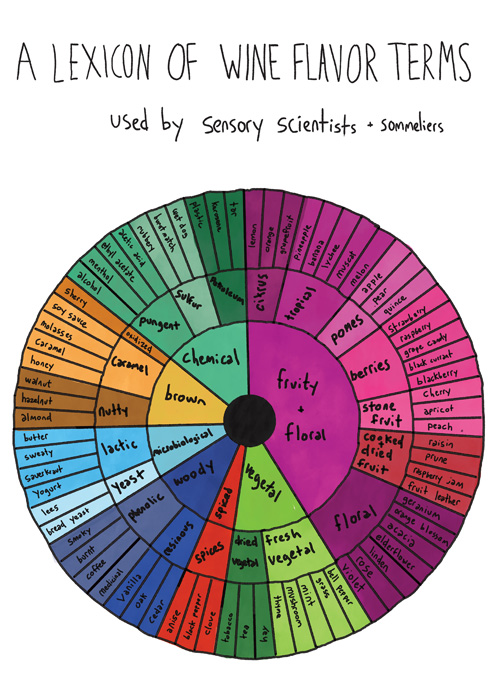The following is an excerpt from Arielle Johnson’s new book, “Flavorama: A Guide to Unlocking the Art and Science of Flavor.” Within its pages, Johnson, a flavor scientist, explores how and why things taste so good, how to make them taste even better, and what that really means on a molecular level. For anyone who loves food and drink and nerding out about either, Johnson’s guide is a fun and fascinating read.
Here, she explores how smell is essential to our perception of flavor, and provides a very useful illustrated lexicon of wine flavor terms used by both scientists and wine industry pros.
As you’ve read till now, tastes are pretty straightforward sensations, and dividing taste into five categories (salty, sour, sweet, umami, bitter) to sort sensations, molecules, and ingredients is so obvious that it might be puzzling to think of how or why you’d do it some other way.
Don’t Miss A Drop
Get the latest in beer, wine, and cocktail culture sent straight to your inbox.
Then, turning to smell, we quickly realize that a simple system of categorization is a luxury we don’t have.
Many industries where smell is important, like wine and perfume, have developed lexicons or categories for those they need to talk about the most — but there’s no decisive, universal breakdown like there is for taste. Smells are irreducibly multifaceted, contain many molecules mixing their signals together, and have a seemingly endless elasticity to accommodate unique sensations. When you smell almost any ingredient you could think of — a quince, a piece of cheese — the perception your brain builds for you is a holistic unit of smell, overlaid with some (but not all) of the distinguishable aroma notes of its individual component molecules.
Thinking about flavor in patterns isn’t just a creative philosophy, a way to apply limitations to a limitless set of possibilities to spur on ingenuity (although it is good at that). It’s also how scientists approach studying flavor, particularly the parts of flavor that come from smell. They attack the delicious chaos of aroma from both ends: studying smells and flavor from the bottom up, and studying patterns among them from the (perceptual) top down.

If you want to know what makes a flavor composed of many different molecules tick, you look at it like a pile of laundry — just like you’d sort the shirts and the socks from the delicates, and the lights from the darks, you sort the smell molecules into their own piles, then smell the piles one by one, so you’re only evaluating one kind of molecule at a time. You note down what each pile smells like, ending up with a list that looks like an annotated formula: smell molecules, amounts, and what aromas they contribute to the mix. This approach is great if you want to pinpoint where a particular note of violet or creaminess comes from in the flavor of a particular fruit — you could then go looking for that molecule in other fruits, or change how you grow or process the plant to get more of it.
The other way we study flavors — the top-down, patterns-focused approach — really embraces the “unbridled” part of flavor: lots of molecules all doing their thing at the same time, lots of aroma qualities happening at once, odor images synergizing and condensing into wholes, ingredients with flavors that are obviously different, in that we can tell them apart, but have more similarities with one another than they do with ingredients that are a lot more different, like oregano and rosemary vs. basil or cilantro. Rather than just throw our hands up and say, “They’re all different,” or compare how every single component of one flavor compares to every component of another, we invented the scientific term multivariate to encapsulate “lots of things are happening all at once, different things are changing different amounts, and we can’t really separate all of it into simple parts with one unifying mechanism to explain them.”